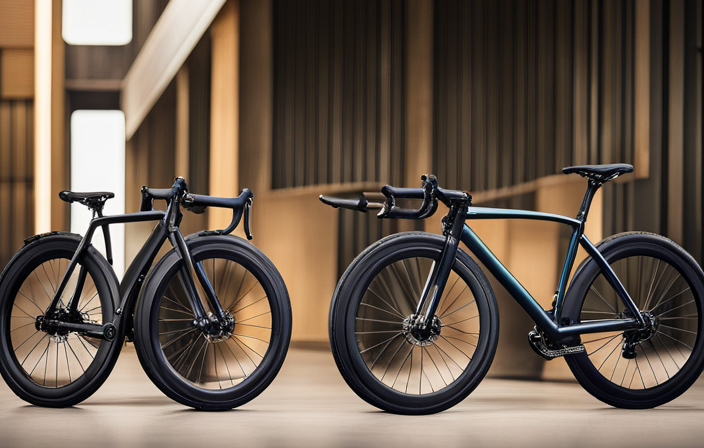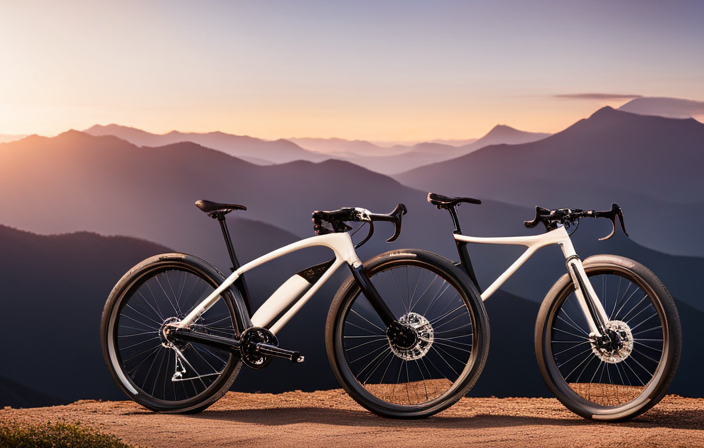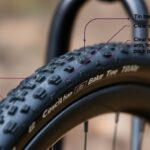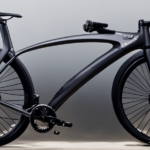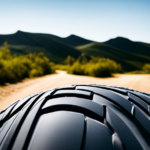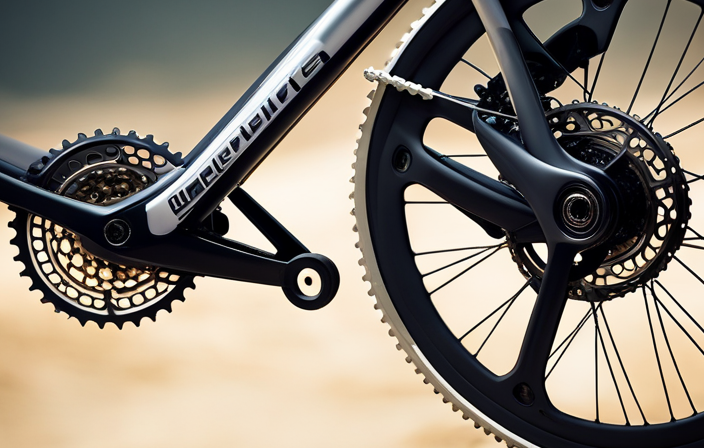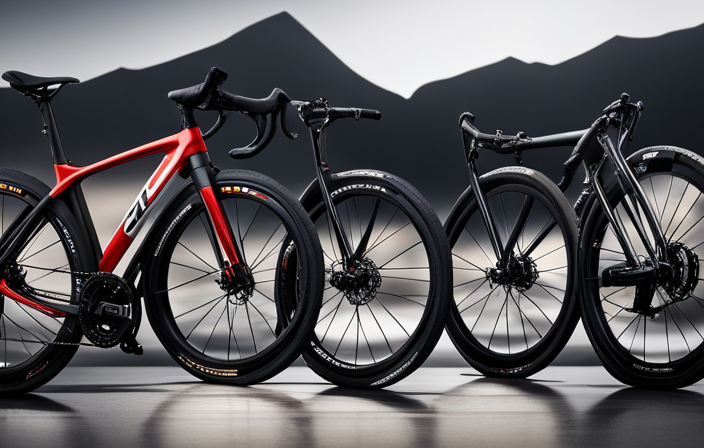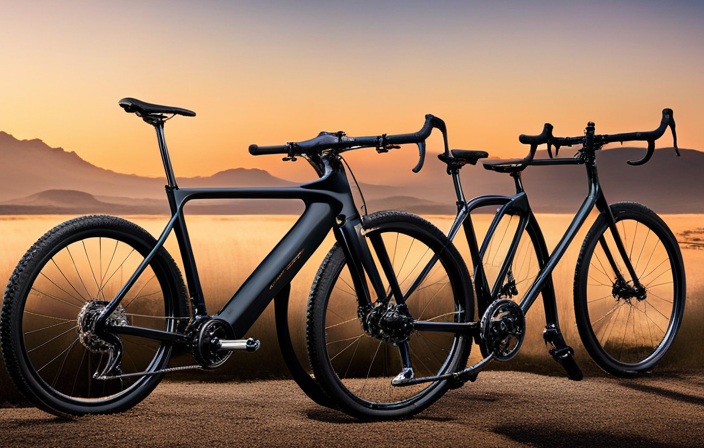Do you often feel every bump and jolt while riding your gravel bike? Don’t worry, I have the perfect solution to make your rides smoother and more comfortable.
In this article, I will guide you through a series of practical steps to enhance your gravel biking experience. From selecting the right frame size and adjusting your bike fit to upgrading your saddle and using wider tires with lower tire pressure, we’ll explore various ways to maximize comfort on bumpy terrains.
So sit back, relax, and let’s dive into the world of making a gravel bike more comfortable!
Key Takeaways
- Choose the right frame size and geometry for a comfortable riding position
- Upgrade components such as saddle, handlebars, and tires for enhanced comfort
- Consider installing suspension systems and vibration-dampening handlebars to reduce vibrations and impacts
- Optimize bike fit, including saddle selection and adjusting stack height and reach length, for optimal comfort on gravel terrain
Choose the Right Frame Size and Geometry
You should choose the right frame size and geometry to make your gravel bike more comfortable.
The first thing to consider is the bike frame materials. Different materials have different characteristics that can affect comfort. Steel frames, for example, are known for their smooth ride quality due to their natural dampening properties. Aluminum frames, on the other hand, are lighter but can be stiffer, which may result in a harsher ride. Carbon fiber frames offer a great balance between lightness and comfort as they absorb road vibrations well.
Another important factor is the bike frame stiffness. A stiffer frame can transfer power more efficiently, but it can also transmit more vibrations to the rider, leading to discomfort on rough roads. On the other hand, a more compliant or flexible frame can help absorb those vibrations and provide a smoother ride.
When choosing the geometry of your gravel bike frame, consider factors such as stack height and reach length. A higher stack height allows for a more upright riding position, which can reduce strain on your back and neck during long rides. Adjusting the reach length can also affect your comfort by determining how stretched out or relaxed you are while riding.
To further enhance your comfort while riding your gravel bike, you should also adjust your bike fit accordingly without compromising performance or safety.
Adjust Your Bike Fit
Start by adjusting the fit of your gravel bike. Proper bike fit adjustment is essential for optimizing comfort and performance.
To begin, ensure that your saddle height is correctly set. The ideal saddle height allows for a slight bend in the knee when the pedal is at its lowest position.
Next, adjust the fore-aft position of your saddle. This affects your pedaling efficiency and overall comfort. A good starting point is to position the saddle so that when you place your heel on the pedal at its furthest point, your leg should be fully extended with a slight bend in the knee.
Furthermore, consider adjusting the handlebar height and reach. The handlebars should be positioned at a comfortable height that allows for a relaxed riding posture without straining your neck or back. Experiment with different stem lengths and angles to find the optimal reach that suits your body proportions.
By making these bike fit adjustments, you can greatly enhance comfort during long rides on gravel terrain. Once you have optimized your bike fit, it’s time to upgrade your saddle to further improve comfort and support while riding.
SUBSEQUENT SECTION: ‘Upgrade Your Saddle’
Upgrade Your Saddle
To enhance your riding experience, consider upgrading the saddle on your gravel bike. Saddle selection is crucial for comfort and performance, as it directly affects how you sit and distribute weight on the bike. When choosing a new saddle, it’s important to take into account your body type, riding style, and personal preferences.
Proper bike fit is essential when selecting a saddle. A professional bike fitting can help determine the optimal saddle width and shape for your body. This ensures that your sit bones are properly supported, reducing pressure points and discomfort during long rides.
When trying out different saddles, pay attention to padding thickness and materials. Some riders prefer more cushioning for added comfort, while others may find that too much padding creates unwanted friction or reduces support. Additionally, consider the nose shape of the saddle; a wider nose can provide better support when climbing steep hills or in aggressive riding positions.
Upgrading your saddle can significantly improve ride comfort on a gravel bike. However, keep in mind that it’s just one aspect of overall comfort enhancement. In the subsequent section about ‘use wider tires and lower tire pressure,’ we will explore another method to further optimize your gravel biking experience without compromising performance.
Use Wider Tires and Lower Tire Pressure
Consider using wider tires and lowering the tire pressure on your gravel bike to enhance your riding experience. Wider tires provide several benefits when riding on gravel or rough terrain. They offer increased stability, better traction, and improved shock absorption. By increasing the surface area in contact with the ground, wider tires distribute your weight more evenly, reducing the risk of sinking into loose gravel or losing control on bumpy surfaces.
In addition to wider tires, lowering the tire pressure can further improve comfort on a gravel bike. Lowering the tire pressure allows for better grip and increases the amount of cushioning between you and the road. This helps to smooth out bumps and vibrations, providing a more comfortable ride.
When considering tire width, it’s important to also think about your handlebars. Wider handlebars can provide added stability and control while riding off-road. They give you greater leverage when steering through obstacles and help maintain balance over uneven terrain.
To take comfort even further, installing suspension systems on your gravel bike can greatly reduce vibrations and impacts from rough surfaces. These systems absorb shocks, allowing you to ride longer without feeling fatigued or sore.
By incorporating wider tires, lower tire pressure, wider handlebars, and possibly adding a suspension system to your gravel bike setup, you can significantly increase comfort during your rides off-road.
Next section: ‘Install Suspension Systems’.
Install Suspension Systems
Installing suspension systems on your gravel bike can greatly enhance the comfort of your rides off-road. Here are four ways to explore alternative shock absorbers:
-
Front Suspension Fork: One of the most common suspension systems for gravel bikes is a front suspension fork. This component attaches to the front wheel and absorbs impacts from rough terrain, providing a smoother ride.
-
Seatpost Suspension: Another option is a seatpost suspension system, which replaces your traditional rigid seatpost with one that has built-in suspension. This helps to absorb vibrations and shocks, reducing fatigue on long rides.
-
Frame Suspension: Some gravel bikes come with frame suspension, where the rear triangle of the bike has flex built into it to provide some level of shock absorption. This can improve overall comfort by dampening vibrations from uneven surfaces.
-
Stem Suspension: A less common but still effective option is a stem suspension system. This involves replacing your traditional stem with one that incorporates a spring or elastomer mechanism, adding another layer of cushioning to absorb shocks.
By installing these suspension systems on your gravel bike, you can significantly increase its comfort off-road and make it more enjoyable to ride over rough terrain. Investing in vibration-dampening handlebars is another way to further improve comfort and reduce fatigue on long rides without compromising performance or control.
Invest in Vibration-Dampening Handlebars
Try investing in vibration-dampening handlebars for your gravel bike to enhance your riding experience and reduce fatigue on rough terrains. Vibration dampening handlebars are designed to absorb the vibrations caused by uneven surfaces, providing a smoother ride and reducing the strain on your hands, wrists, and arms. These handlebars often incorporate various technologies such as elastomers or damping materials to minimize vibrations.
When choosing vibration dampening handlebars, consider the different options available. Some manufacturers offer specific models designed for off-road use, which may have additional features like wider profiles or increased compliance. Additionally, there are different types of handlebar tape options that can further enhance comfort by adding an extra layer of cushioning between your hands and the handlebars.
One popular option is gel-backed tape, which has a layer of gel padding underneath the outer layer of tape. This provides additional shock absorption and reduces the impact of road vibrations on your hands. Another option is using gel inserts that can be placed directly under the bar tape for extra cushioning.
By investing in vibration-dampening handlebars and exploring different handlebar tape options, you can significantly improve the comfort of your gravel bike.
Next, we will discuss how to add bar tape or gel inserts for extra cushioning without compromising performance.
Add Bar Tape or Gel Inserts for Extra Cushioning
One way to enhance your riding experience on rough terrains is by adding bar tape or gel inserts for extra cushioning on your handlebars. This simple modification can significantly improve comfort and reduce fatigue during long rides.
Adding extra cushioning to the saddle is essential, but it’s equally important to focus on the handlebars as they directly impact your hands and arms.
When selecting bar tape or gel inserts, opt for options specifically designed for gravel biking. These materials are designed to absorb vibrations and provide additional padding. Look for padded handlebar tape that has a thick layer of foam or gel underneath the outer surface. This will help to dampen road vibrations and provide a more comfortable grip.
To install the bar tape or gel inserts, start by removing any existing tape from your handlebars. Clean the bars thoroughly before applying the new material. Begin wrapping from one end of the handlebar towards the other, making sure to pull it tightly as you go along. Secure it in place with adhesive strips or electrical tape.
By incorporating these modifications into your gravel bike setup, you’ll experience increased comfort and reduced hand fatigue during rides over rough terrain. Adding extra cushioning to both your saddle and handlebars is just one step towards creating a more enjoyable riding experience.
Next, let’s explore how wearing padded cycling shorts can further enhance comfort on long rides without compromising performance.
Wear Padded Cycling Shorts
Wearing padded cycling shorts can greatly enhance your riding experience on rough terrains. Cycling shorts provide several benefits that contribute to increased comfort during long gravel rides. The padding, known as a chamois, is designed to reduce friction and provide cushioning between your body and the saddle. This extra layer of protection helps to absorb shock and impact, minimizing discomfort and preventing chafing or soreness.
In addition to padded shorts, there are alternative saddle options available that can further improve comfort on a gravel bike. Some saddles feature gel inserts or foam padding, which provide additional cushioning for your sit bones. These specialized saddles distribute pressure more evenly across the buttocks, reducing the risk of numbness or hotspots.
When choosing cycling shorts and saddles for a gravel bike, it’s important to consider factors such as fit, material quality, and personal preferences. Investing in high-quality padded shorts made from breathable materials will ensure maximum comfort during long rides. Likewise, experimenting with different saddle designs can help find the perfect match for your body shape and riding style.
To enhance comfort even further on rough terrains, opt for a shock-absorbing seatpost. This component absorbs vibrations and impacts from uneven surfaces, reducing the strain on your lower back and providing an overall smoother ride experience.
Opt for Shock-Absorbing Seatpost
To make a gravel bike more comfortable, wearing padded cycling shorts is a great start. However, there are additional steps you can take to enhance your riding experience.
One option is to opt for a shock-absorbing seatpost. A shock-absorbing seatpost is designed to reduce vibrations and absorb impacts from rough terrain. It works by using either a spring mechanism or elastomers to provide cushioning and dampening effects. This helps to minimize the impact on your body, especially during long rides on uneven surfaces.
When choosing a shock-absorbing seatpost, consider factors such as weight capacity, adjustability, and the amount of travel it offers. Look for features like adjustable preload and rebound damping settings that allow you to fine-tune the suspension according to your preferences.
Additionally, another way to improve comfort on your gravel bike is by using bike seat cushions and shock-absorbing handlebar tape. These accessories provide extra padding and cushioning where it matters most – at the contact points between you and the bike.
By incorporating these upgrades into your gravel bike setup, you can significantly reduce fatigue and discomfort during long rides over rough terrains. The next step in maximizing comfort is installing a suspension fork…
Continue reading about how to install a suspension fork for further improvements in ride quality.
Install a Suspension Fork
Installing a suspension fork can greatly enhance the ride quality of your gravel bike. By absorbing impacts and vibrations from rough terrain, it provides a smoother and more comfortable riding experience. When combined with other suspension components such as a suspension seatpost or a suspension seat tube, the overall comfort level is further improved.
To install a suspension fork, start by removing the existing rigid fork from your bike frame. Ensure that the new suspension fork you choose is compatible with your frame’s specifications, including axle size and steerer tube diameter. Install the new fork by inserting the steerer tube into the headtube of your frame and securing it with a compression plug or star nut.
Once properly installed, adjust the air pressure in the suspension fork according to your weight and riding preferences. This will optimize its performance and ensure optimal comfort while riding on gravel roads.
Consider tubeless tires for smoother rides without worrying about pinch flats or punctures caused by sharp rocks or debris on unpaved surfaces. Tubeless setups allow you to run lower tire pressures for increased traction and better shock absorption.
By installing a suspension fork and considering tubeless tires, you can transform your gravel bike into an even more comfortable machine ready to tackle any adventure on rough terrains ahead.
Consider Tubeless Tires for Smoother Rides
By opting for tubeless tires, you can experience a smoother ride on your gravel bike without worrying about pinch flats or punctures. Tubeless tire benefits include improved traction, reduced rolling resistance, and enhanced comfort.
Here’s how to set up tubeless tires on your gravel bike:
-
Choose the right tubeless-ready tire: Look for tires specifically designed for tubeless setups. These tires have reinforced sidewalls and bead locks to secure the tire onto the rim.
-
Prepare the rim: Clean the rim thoroughly and apply a layer of tubeless rim tape to seal any spoke holes. This prevents air from escaping through the rim.
-
Install the valve stem: Insert a tubeless valve stem into the rim and tighten it securely. This is where you’ll inject sealant later on.
Once you’ve set up your gravel bike with tubeless tires, you’ll notice a significant improvement in ride quality. The absence of inner tubes allows for lower tire pressures, resulting in better shock absorption over rough terrain. Additionally, tubeless tires provide increased grip when cornering or braking, enhancing overall control and stability.
To further enhance comfort on your gravel bike, consider using gel or foam handlebar grips that absorb vibrations from uneven surfaces seamlessly.
Transitioning into the subsequent section about ‘use gel or foam handlebar grips’, remember that these grips can significantly reduce hand fatigue during long rides without compromising control or handling performance.
Use Gel or Foam Handlebar Grips
After considering tubeless tires for a smoother ride on your gravel bike, it’s time to focus on another crucial aspect of comfort: handlebar grips. When riding off-road or over rough terrain, the vibrations and impacts can be harsh on your hands and wrists. That’s where foam or gel handlebar grips come into play.
Foam grips are lightweight and offer excellent shock absorption. They provide a soft and cushioned feel, reducing hand fatigue during long rides. On the other hand, gel grips are known for their ability to conform to your hands, providing a custom fit and enhanced comfort. The gel material absorbs vibrations effectively, resulting in a more pleasant riding experience.
Choosing between foam and gel handlebar grips ultimately comes down to personal preference. Some riders may prefer the plushness of foam grips, while others may opt for the tailored feel of gel grips.
Regardless of the type you choose, it is essential to prioritize handlebar grip comfort. By minimizing vibrations and impact forces transmitted to your hands and arms, you can reduce discomfort and prevent potential injuries.
Now that we’ve discussed enhancing comfort through handlebar grips let’s delve into another way to make your gravel bike even more comfortable – installing a Thudbuster or Shockstop stem.
Install a Thudbuster or Shockstop Stem
To enhance your riding experience, consider adding a Thudbuster or Shockstop stem to your gravel bike. These suspension systems can greatly improve the comfort and control of your bike, especially when riding on rough terrain.
Here are three key benefits of using a Thudbuster or Shockstop stem:
-
Enhanced Comfort: Both the Thudbuster and Shockstop stems are designed to absorb shocks and vibrations, providing a smoother ride over bumpy surfaces. This means less fatigue on your hands, arms, and upper body, allowing you to ride longer without discomfort.
-
Improved Control: By reducing the impact of bumps and uneven surfaces, these suspension systems help maintain better traction and stability. This translates into improved handling and maneuverability, giving you more confidence to tackle challenging terrains.
-
Customizable Suspension: The Thudbuster offers different elastomer inserts that allow you to adjust the level of suspension based on your weight and personal preference. On the other hand, the Shockstop stem utilizes an adjustable coil spring system for fine-tuning the suspension according to your needs.
While both options provide significant benefits in terms of comfort and control, it’s important to note that they also have some drawbacks. The Thudbuster can add weight to your bike due to its unique design, while the Shockstop stem may require additional maintenance due to its coil spring mechanism.
To further enhance comfort during long rides on your gravel bike, consider using gloves with padding or gel inserts.
Use Gloves with Padding or Gel Inserts
Wearing gloves with padding or gel inserts can significantly increase the comfort of your rides on rough terrain. When cycling on gravel roads or bumpy trails, the constant vibrations and jolts can cause discomfort and fatigue in your hands and wrists. Investing in a good pair of cycling gloves with adequate padding or gel inserts can help absorb some of these shocks, providing a cushioning effect that reduces strain on your upper body.
Cycling gloves with padding are designed to distribute pressure evenly across your palms, reducing the impact of vibrations from uneven surfaces. The padding acts as a barrier between your hands and the bike handlebars, absorbing shocks and preventing numbness or tingling sensations. Gel inserts take this comfort to the next level by conforming to the shape of your hand, providing personalized support where you need it most.
In addition to enhancing comfort, padded gloves also offer better grip on the handlebars. This is especially important when riding off-road, as it helps maintain control over rough terrain and prevents slips or accidents.
By using gloves with padding or gel inserts, you can enjoy longer rides without experiencing excessive discomfort. However, it’s important to remember that even with enhanced comfort measures like these gloves, taking regular breaks and stretching during long rides is still crucial for maintaining optimal performance and preventing muscle fatigue.
Transition: In order to further optimize your gravel bike’s comfort levels, let’s explore the importance of taking regular breaks and stretching during long rides.
Take Regular Breaks and Stretch During Long Rides
During long rides on a gravel bike, it is crucial to prioritize comfort in order to maintain optimal performance and avoid discomfort or injury. In my previous subtopic, I discussed the use of gloves with padding or gel inserts as one way to enhance comfort. Now, let’s explore another essential aspect: taking regular breaks and stretching.
When embarking on extended rides, it is important to listen to your body’s signals and take breaks accordingly. This not only allows you to rest and recover but also helps prevent muscle fatigue and stiffness. During these breaks, make sure to incorporate stretching exercises that target key muscles used while cycling.
In addition to breaks and stretching, proper hydration is paramount for maintaining comfort during long rides on a gravel bike. Staying hydrated helps regulate body temperature, prevents cramping, and ensures optimal performance. It is recommended to drink water regularly throughout the ride and consider using electrolyte-enhanced fluids for added benefit.
Moreover, utilizing a bike computer can greatly contribute to overall comfort by providing real-time data on distance covered and speed achieved. This information allows you to pace yourself effectively and track progress towards your goals.
By implementing these strategies—taking regular breaks with appropriate stretches and prioritizing hydration—you can significantly enhance the comfort of your gravel bike rides while maximizing your performance potential.
Frequently Asked Questions
How do I choose the right frame size and geometry for my gravel bike?
To choose the right gravel bike frame size and geometry for optimal comfort, start by considering your height and inseam measurement. Use a sizing chart provided by the manufacturer to determine the appropriate frame size.
Next, analyze the bike’s geometry, specifically looking at factors like stack height and reach length to ensure a comfortable riding position.
Adjusting the bike fit, such as saddle height and handlebar position, can further enhance comfort on your gravel bike.
What are some tips for adjusting my bike fit to make it more comfortable?
To make my bike more comfortable, I can start by making some adjustments to my bike fit.
Firstly, I need to ensure that my saddle height is properly set, allowing for a slight bend in my knee when the pedal is at its lowest position.
Additionally, adjusting the handlebar positioning can relieve strain on my back and shoulders. Finding the right balance between reach and drop will optimize comfort and control while riding.
Are there any specific saddle upgrades that can improve comfort on a gravel bike?
Upgrading your gravel bike’s saddle can significantly enhance comfort during long rides. Consider a saddle with ample padding to provide cushioning and alleviate pressure points.
Additionally, finding the right saddle width is crucial for optimal support and stability. A wider saddle distributes weight more evenly, reducing discomfort in sensitive areas.
The combination of proper padding and an appropriate width will ensure a more enjoyable and comfortable riding experience on your gravel bike.
How do wider tires and lower tire pressure contribute to a more comfortable ride?
Wider tires offer several benefits for a gravel bike. They provide increased stability and traction, especially on loose or rough terrain. However, wider tires can also increase rolling resistance and add weight to the bike.
On the other hand, lower tire pressure helps to absorb vibrations and impacts, resulting in a smoother ride by improving comfort. However, it can negatively affect performance by reducing speed and responsiveness due to increased drag.
What are some options for adding suspension systems to a gravel bike for increased comfort?
Suspension systems can greatly enhance the comfort of a gravel bike. One option is to install a suspension seatpost, which absorbs shocks and vibrations from uneven terrain. This reduces the impact on your body, minimizing fatigue and discomfort.
Another option is adding handlebar gel pads, which provide cushioning for your hands and wrists. These absorb road vibrations and reduce pressure points, resulting in a more comfortable riding experience.
Combining these two options can significantly improve the overall comfort of your gravel bike.
Conclusion
In conclusion, I have found that making your gravel bike more comfortable is not only possible but also necessary for an enjoyable riding experience.
By carefully choosing the right frame size and geometry, adjusting your bike fit, upgrading your saddle, and using wider tires with lower tire pressure, you can significantly improve the comfort of your gravel bike.
Installing suspension systems and handlebar grips with gel or foam padding, as well as utilizing gloves with padding or gel inserts, are also effective ways to enhance comfort.
Additionally, taking regular breaks and stretching during long rides will help prevent muscle fatigue and discomfort.
So go ahead and make these modifications to enhance your comfort on those long gravel adventures!
